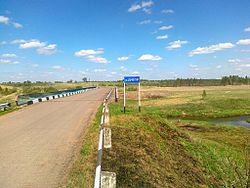Kholm-Zhirkovsky District
Холм-Жирковский район | |
|---|---|
 Bridge over Dnieper River, Nakhimovskoe, Kholm-Zhirkovsky District | |
 Location of Kholm-Zhirkovsky District in Smolensk Oblast | |
| Coordinates: 55°30′53″N 33°29′56″E / 55.51472°N 33.49889°E | |
| Country | Russia |
| Federal subject | Smolensk Oblast[1] |
| Established | 1 October 1929 |
| Administrative center | Kholm-Zhirkovsky[1] |
| Area | |
• Total | 2,033.40 km2 (785.10 sq mi) |
| Population | |
• Total | 10,717 |
| • Density | 5.3/km2 (14/sq mi) |
| • Urban | 32.6% |
| • Rural | 67.4% |
| Administrative structure | |
| • Administrative divisions | 1 Urban settlements, 14 Rural settlements |
| • Inhabited localities[1] | 1 Urban-type settlements[3], 177 rural localities |
| Municipal structure | |
| • Municipally incorporated as | Kholm-Zhirkovsky Municipal District[4] |
| • Municipal divisions[4] | 1 urban settlements, 14 rural settlements |
| Time zone | UTC+3 (MSK |
| OKTMO ID | 66654000 |
| Website | http://holm.admin-smolensk.ru/ |
Kholm-Zhirkovsky District (Russian: Холм-Жирковский райо́н) is an administrative[1] and municipal[4] district (raion), one of the twenty-five in Smolensk Oblast, Russia. It is located in the north of the oblast. The area of the district is 2,033.40 square kilometers (785.10 sq mi).[1] Its administrative center is the urban locality (a settlement) of Kholm-Zhirkovsky.[1] Population: 10,717 (2010 Census);[2] 12,815 (2002 Census);[6] 15,966 (1989 Soviet census).[7] The population of the administrative center accounts for 32.6% of the district's total population.[2]
- ^ a b c d e f g Resolution #261
- ^ a b c Russian Federal State Statistics Service (2011). Всероссийская перепись населения 2010 года. Том 1 [2010 All-Russian Population Census, vol. 1]. Всероссийская перепись населения 2010 года [2010 All-Russia Population Census] (in Russian). Federal State Statistics Service.
- ^ The count of urban-type settlements may include the work settlements, the resort settlements, the suburban (dacha) settlements, as well as urban-type settlements proper.
- ^ a b c Law #137-z
- ^ "Об исчислении времени". Официальный интернет-портал правовой информации (in Russian). June 3, 2011. Retrieved January 19, 2019.
- ^ Federal State Statistics Service (May 21, 2004). Численность населения России, субъектов Российской Федерации в составе федеральных округов, районов, городских поселений, сельских населённых пунктов – районных центров и сельских населённых пунктов с населением 3 тысячи и более человек [Population of Russia, Its Federal Districts, Federal Subjects, Districts, Urban Localities, Rural Localities—Administrative Centers, and Rural Localities with Population of Over 3,000] (XLS). Всероссийская перепись населения 2002 года [All-Russia Population Census of 2002] (in Russian).
- ^ Всесоюзная перепись населения 1989 г. Численность наличного населения союзных и автономных республик, автономных областей и округов, краёв, областей, районов, городских поселений и сёл-райцентров [All Union Population Census of 1989: Present Population of Union and Autonomous Republics, Autonomous Oblasts and Okrugs, Krais, Oblasts, Districts, Urban Settlements, and Villages Serving as District Administrative Centers]. Всесоюзная перепись населения 1989 года [All-Union Population Census of 1989] (in Russian). Институт демографии Национального исследовательского университета: Высшая школа экономики [Institute of Demography at the National Research University: Higher School of Economics]. 1989 – via Demoscope Weekly.

